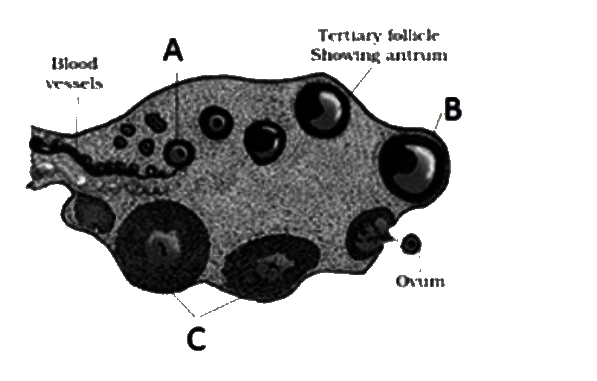What is Graafian follicle?
Step-by-Step Text Solution for the Question: What is Graafian Follicle?
1. Definition: The Graafian follicle is a structure found in the female reproductive system, specifically within the mammalian ovary. It plays a crucial role in the process of ovulation.
2. Formation: The Graafian follicle forms just before ovulation, typically around the 14th day of the menstrual cycle. This is when the ovum (egg) reaches maturity.
3. Structure: The Graafian follicle consists of a fluid-filled cavity known as the antrum. The antrum provides a protective environment for the developing ovum.
4. Components:
- The ovum is located at the center of the Graafian follicle.
- The follicle is surrounded by several layers of cells, including:
- Granulosa Cells: These cells line the follicle and are involved in nourishing the ovum.
- Corona Radiata: This is a layer of cells that directly surrounds the ovum, providing additional support and protection.
5. Function: The primary function of the Graafian follicle is to protect the ovum and ensure its viability until it is released during ovulation. The fluid within the antrum helps cushion the ovum, preventing damage.
6. Role in Ovulation: On the 14th day of the menstrual cycle, the Graafian follicle ruptures, releasing the mature ovum into the fallopian tube, where it may be fertilized.
- The ovum is located at the center of the Graafian follicle.
- The follicle is surrounded by several layers of cells, including:
- Granulosa Cells: These cells line the follicle and are involved in nourishing the ovum.
- Corona Radiata: This is a layer of cells that directly surrounds the ovum, providing additional support and protection.
Topper's Solved these Questions
- HUMAN REPRODUCTIONBOOK - MODERN PUBLICATIONCHAPTER - HUMAN REPRODUCTIONEXERCISE - PRACTICE PROBLEM (GAMETOGENESIS AND GAMETS)
21 Videos
- HUMAN REPRODUCTIONBOOK - MODERN PUBLICATIONCHAPTER - HUMAN REPRODUCTIONEXERCISE - PRACTICE PROBLEM (REPRODUCTIVE CYCLE)
12 Videos
- HUMAN HEALTH AND DISEASESBOOK - MODERN PUBLICATIONCHAPTER - HUMAN HEALTH AND DISEASESEXERCISE - Chapter Practice Test
2 Videos
- MICROBES IN HUMAN WELFAREBOOK - MODERN PUBLICATIONCHAPTER - MICROBES IN HUMAN WELFAREEXERCISE - CHAPTER PRACTICE TEST (Long Answer Type Question )(Five marks each)(Section -E)
8 Videos
Similar Questions
The figure shows a section of the human ovary . select the option which gives the correct identification of A,B,C .

(i) A is a group of primary follicles that gradually matures under the influence of LG and FSH
(ii) C is the Graafian follicles which starts producing a hormone celled progesterone.
(iii) C is a corpus luteum that secretes FSH.
(iv) B is the Graafian follicles which ruptures during mid of the cycle.
View SolutionAfter ovulation Graafian follicle transforms into
View Solution
Knowledge Check
In a Graafian follicle:
Aeggs are fertilizedBthere are many oocytesCthere are many spermsDthere is a single oocyteWhich of the following is found inside Graafian follicle?
ACortexBMedullaCCorpus luteumDMembrane granulosaAfter ovulation, Graafian follicle forms
ACorpus luteumBCorpus albicanasCCorpus artesiaDCorpus callosum.
In a maturing Graafian follicle the granulosa cells secrete ……… into the blood .
View SolutionAssertion : In post natal life , oocyte development occurs in mature follicle
Reason : After ovulation , Graafian follicle transforms in corpus luteum
View SolutionGraafian follicle contains
View SolutionGraafian follicles contain
View SolutionGraafian follicle contains
View Solution
